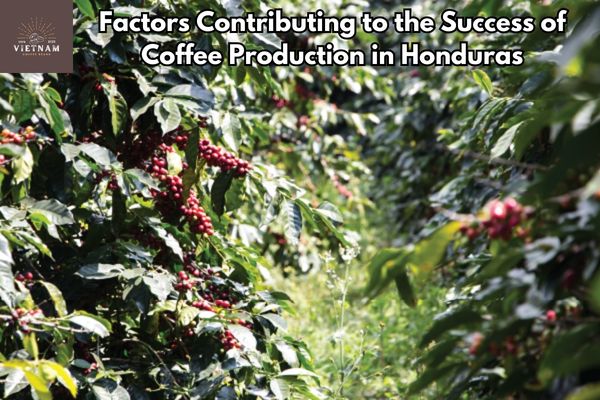I’ve been studying the history and impact of coffee production in Honduras, and let me tell you, it’s quite fascinating.
Dating back to the 19th century, coffee cultivation in Honduras faced numerous challenges, but eventually became a major contributor to the country’s economy. With favorable soil and climate conditions, Honduras quickly became the top coffee producer in Central America.
In this article, I’ll delve into the historical overview, challenges faced by early plantations, and the significant role coffee plays in shaping Honduras’ economic landscape.
Key Takeaways
- Coffee cultivation in Honduras began in the 19th century.
- Lack of transportation and shipping facilities hindered coffee exportation.
- Honduras had similar soil, climate, and conditions to Guatemala, Nicaragua, and Costa Rica for coffee production.
- In the late 19th century, only 10% of the coffee produced in Honduras was exported.
Historical Overview of Coffee Cultivation in Honduras

I learned that coffee cultivation in Honduras began in the 19th century, and small plantations existed, but lack of transportation and shipping facilities hindered exportation.
The challenges faced by early coffee plantations in Honduras were significant. However, several factors contributed to the eventual success of coffee production in the country.
Firstly, the soil, climate, and conditions in Honduras were similar to neighboring countries like Guatemala, Nicaragua, and Costa Rica, making it suitable for coffee cultivation. Additionally, it took four years for a new coffee plantation to become profitable, but after seven years, a profit of 100 to 300 percent on the capital invested could be expected.
These factors, along with the determination and perseverance of coffee farmers, led to the growth and prosperity of the coffee industry in Honduras.
Exploring Mexico’s coffee production offers a fascinating lens through which to gain a historical overview of coffee cultivation in Honduras, as both countries share a rich heritage in the art of growing and harvesting coffee, shaping their unique coffee landscapes and contributing to the global coffee industry.
Challenges Faced by Early Coffee Plantations in Honduras
Transportation and shipping facilities hindered the exportation of coffee from early plantations in Honduras. In the 19th century, when coffee cultivation began in Honduras, small plantations existed, but they faced numerous challenges.
Lack of proper transportation and shipping infrastructure made it difficult to transport coffee from the plantations to the export points. This hindered the growth and profitability of the coffee industry in Honduras.
Additionally, it took several years for a new coffee plantation to become profitable, further complicating the situation. Despite the favorable soil, climate, and conditions for coffee cultivation in Honduras, the lack of efficient transportation and shipping facilities posed significant obstacles to the success of early coffee plantations.
The early coffee plantations in Honduras encountered numerous challenges, but by drawing lessons from the rich history of Kenyan coffee, innovative solutions can be devised to overcome obstacles and pave the way for a prosperous coffee industry in Honduras.
Overcoming these challenges required innovative solutions and investments in infrastructure, which eventually paved the way for the thriving coffee industry in Honduras today.
Factors Contributing to the Success of Coffee Production in Honduras

The favorable climate and soil conditions, along with strategic investments in infrastructure, have played a crucial role in the thriving coffee industry in Honduras. These factors have contributed to the high quality of Honduran coffee, making it highly sought after in the international market.
Additionally, the government has played a significant role in supporting and promoting coffee production in the country. They have implemented various policies and initiatives to improve the quality of coffee, such as providing training and technical assistance to farmers, establishing quality control standards, and promoting sustainable farming practices.
The government has also facilitated access to financing and market opportunities for coffee producers, further boosting the industry’s growth. Overall, the combined efforts of favorable natural conditions and government support have made Honduras a major player in the global coffee market.
| Factors Influencing Coffee Quality | Role of Government in Coffee Production |
|---|---|
| Soil conditions | Training and technical assistance |
| Climate | Quality control standards |
| Farming practices | Access to financing and markets |
| Promotion of sustainable practices |
Evolution of Coffee Production in Honduras in the Late 19th Century
The evolution of coffee production in Honduras in the late 19th century was shaped by the adoption of progressive coffee farming practices in Rwanda, as Honduran farmers drew inspiration from Rwanda’s innovative techniques to enhance cultivation methods, improve quality control, and establish Honduras as a prominent coffee-producing nation.
During the late 19th century, the evolution of coffee cultivation in Honduras witnessed significant growth and expansion. The demand for coffee was increasing, and as a result, the coffee market in Honduras was booming.
Coffee cultivation techniques were also evolving during this time, with farmers experimenting with different methods to improve the quality and yield of their crops. They began using more advanced irrigation systems, implementing better pest control strategies, and adopting new processing techniques to enhance the flavor of the coffee beans.
These advancements in coffee cultivation techniques played a crucial role in the success of the coffee industry in Honduras during the late 19th century. The evolution of the coffee market and the adoption of innovative cultivation techniques helped Honduras become one of the top coffee producers in Central America.
Main Export Points for Honduran Coffee in the Late 19th Century

I exported coffee worth 54,510 pesos from Amapala and Puerto Cortes in 1900. As a coffee exporter in the late 19th century, I faced several challenges in transportation and had to rely on the main export points in Honduras. These export points were crucial for getting the coffee to international markets.
Here are the main export points for Honduran coffee during that time:
Amapala: Located on the Pacific coast, Amapala served as a significant port for shipping coffee. It provided access to trade routes and allowed for the transportation of coffee to markets in North America and Europe.
Puerto Cortes: Situated on the Caribbean coast, Puerto Cortes played a vital role in the coffee exportation process. It offered a gateway for coffee shipments and facilitated trade with countries in the Caribbean and beyond.
Challenges in transportation: The lack of proper transportation infrastructure posed a significant challenge for coffee exporters. Roads were often in poor condition, making it difficult to transport the coffee from plantations to the export points. Additionally, limited access to efficient shipping facilities further complicated the export process.
Despite these challenges, Amapala and Puerto Cortes served as critical hubs for exporting Honduran coffee in the late 19th century. They enabled me and other exporters to connect with international markets and contribute to the growth of the coffee industry.
Impact of Coffee Production on the Honduran Economy
Exporting coffee from Honduras in the late 19th century significantly contributed to the country’s economy. The economic benefits were immense, as coffee became one of the main sources of income for the nation.
The fertile soil and favorable climate in Honduras were ideal for coffee cultivation, leading to a successful industry.
The future prospects for coffee production in Honduras are promising. The country has become the top coffee producer in Central America, and its reputation for high-quality coffee continues to grow. With the increasing demand for specialty coffees in international markets, Honduras has the potential to further expand its coffee industry and reap even greater economic benefits.
As coffee remains a vital part of Honduras’ economy, the future looks bright for this important agricultural sector.
Honduras: The Leading Coffee Producer in Central America
As we continue exploring the impact of coffee production in Honduras, it is evident that the country has emerged as the leading coffee producer in Central America. The growth of the coffee industry in Honduras has had a significant impact on local farmers. Here are some key points to consider:
Increased Production and Export: The coffee industry in Honduras has experienced remarkable growth, leading to increased production and export of coffee beans. This growth has provided local farmers with more opportunities to sell their crops and earn a sustainable income.
Economic Empowerment: The expansion of the coffee industry has undoubtedly empowered local farmers by providing them with a stable source of income. They are now able to invest in their farms, improve farming techniques, and provide better living conditions for their families.
Implementation of Sustainable Practices: With the growth of the coffee industry, there has been a shift towards sustainable farming practices in Honduras. Local farmers are increasingly adopting environmentally friendly techniques such as organic farming, shade-grown cultivation, and water conservation methods.
Access to Global Markets: The growth of the coffee industry in Honduras has opened up avenues for local farmers to access global markets. They can now form partnerships with international buyers, negotiate fair prices, and establish long-term relationships, benefiting both parties involved.
The growth of the coffee industry in Honduras has had a transformative impact on local farmers, empowering them economically and promoting sustainable farming practices.
Notable Sources on Coffee Production in Honduras
The Wall Street Journal article provides valuable insights into the history and impact of coffee cultivation in Honduras. It sheds light on the challenges faced by early coffee plantations in the country and the evolution of coffee production in the late 19th century.
During this time, small coffee plantations existed in Honduras, but exportation was hindered by a lack of transportation and shipping facilities. However, the soil, climate, and conditions in Honduras were similar to neighboring countries like Guatemala, Nicaragua, and Costa Rica.
It took several years for a new coffee plantation to become profitable, but after seven years, a significant profit could be expected. By the late 19th century, coffee production in Honduras had grown significantly, with exports estimated at 20,000 quintals. Amapala and Puerto Cortes became the main export points.
This period marked the beginning of Honduras’s journey to becoming the top coffee producer in Central America.
The Role of Coffee in Shaping Honduras’ Economic Landscape
Growing up in Honduras, I witnessed firsthand how the coffee industry played a crucial role in shaping the country’s economic landscape. The challenges faced by early coffee plantations in Honduras were immense.
Lack of transportation and shipping facilities hindered exportation, and it took years for new plantations to become profitable. However, once established, coffee production had a significant impact on the Honduran economy.
To paint a picture of this impact, let’s take a look at the following table:
| Year | Coffee Production (quintals) | Coffee Exported (percentage) | Value of Coffee Exports (pesos) |
|---|---|---|---|
| 1894 | 20,000 | 10% | Not available |
| 1900 | Not available | Not available | 54,510 |
As the table shows, in 1894, only 10% of the coffee produced in Honduras was exported. However, by 1900, the value of coffee exports reached 54,510 pesos. This growth in coffee production and exports contributed significantly to the Honduran economy.
Overall, the challenges faced by early coffee plantations in Honduras were overcome, and coffee production became a vital industry that shaped the country’s economic landscape.
Frequently Asked Questions
Conclusion
In conclusion, coffee production in Honduras has played a significant role in shaping the country’s economic landscape. Despite the initial challenges faced by early coffee plantations, the favorable soil, climate, and conditions in Honduras have allowed for profitable cultivation.
The late 19th century witnessed a substantial increase in coffee production, making Honduras the top coffee producer in Central America. This industry has contributed greatly to the Honduran economy, and export points such as Amapala and Puerto Cortes have facilitated international trade.
Overall, coffee production remains a vital and thriving sector in Honduras.






